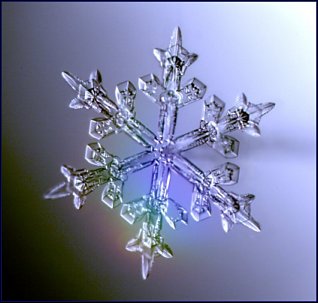

Water comes in many forms. There is the familiar liquid type found in rivers and wells and the drops of rain—and even in diminutive form, clouds. Water vapor, though, is an invisible gas, revealing itself only as it condenses to form clouds in our desert skies. And then there's the solid forms, ice and snow. Yes, ice and snow are not alien to the Chihuahuan Desert, most areas being subjected from time to time. Eskimos are said to have a large vocabulary for snow, but most desert-dweller's comments can be summarized by two phrases: "It's beautiful" and "Go away".
Each snowflake is unique, a marvel unlike any other—or so they
say. As with so many other things that "everyone knows", nobody can prove it,
and no one is going to take the time and effort to try to disprove it. Suffice it to
say that, with the immense numbers of water molecules making up a snowflake and the
almost infinite possible positions for its molecules, the statement is one of the more
easily accepted unprovables.

Contributor: Arthur H. Harris, Laboratory for Environmental Biology, Centennial Museum, University of Texas at El Paso.
Desert Diary is a joint production of the Centennial Museum and KTEP National Public Radio at the University of Texas at El Paso.

A single snowflake. Image courtesy of Kenneth Libbrecht, Caltech.
Original Wilson Bentley Images from the Jerico (VT) Historical Society.
Snowflakes--A
thematic approach. Aimed particularly at teachers, but there's a whole lot
there for anyone. 